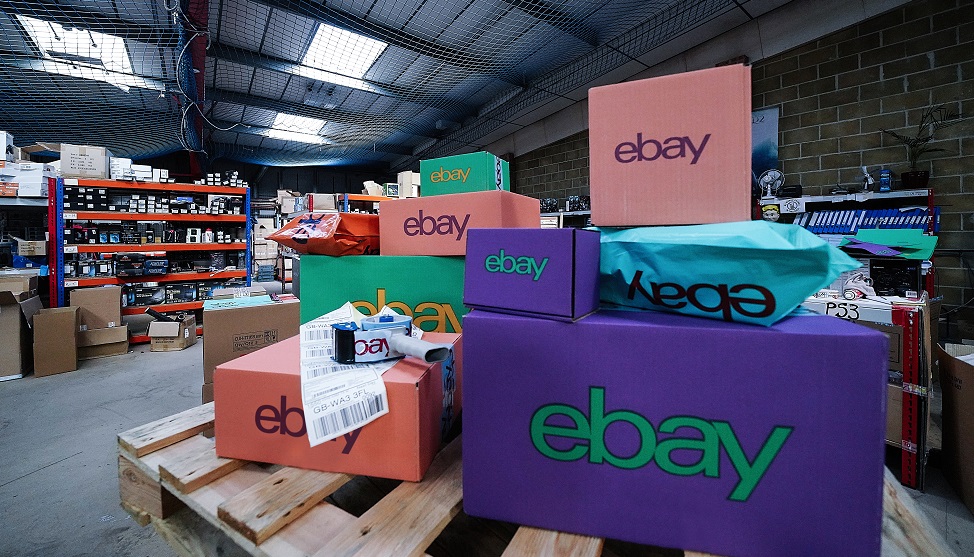
How online delivery services emerged as Britain’s lockdown lifeline

Neil McLauchlan, eBay UK Director of Shipping & Logistics, describes how eBay has kept goods moving during the pandemic despite astronomical demand, delivery and returns uncertainty and constantly changing guidance on imports and exports.
“Since lockdown began in March, the way we live, spend our money and time has changed beyond recognition.
With the majority staying at home and only venturing out to get essentials; businesses and consumers across the UK were confronted with one question – how would we get the goods and services we needed?
The closure of all non-essential physical premises brought significant challenges to British businesses, many of which already faced problems due to changing business models and tougher trading environments on UK high streets.
This year, online delivery services have emerged as the lifeline for so many businesses, both big and small. It was online delivery services that kept Britain’s goods and services moving, in spite of the pandemic.
 eBay was central to this shift to online deliveries – connecting people with products from across the UK, ensuring consumers could get what they needed when they needed it.
eBay was central to this shift to online deliveries – connecting people with products from across the UK, ensuring consumers could get what they needed when they needed it.
To give you an example of the type of demand we were seeing – in April 2020 bike Sales rose by over +239% compared with March 2020. While electric Bike sales were also up +197% in April vs. March this year. This was linked to the rise in people getting active outdoors and looking at ways to avoid public transport.
We also saw a huge increase in the amount of home office equipment, children’s schoolbooks, arts and crafts, and jigsaw puzzles being ordered.
At the same time as the increase in consumers relying on e-commerce, businesses begun to rely on marketplaces, like eBay, more than ever before. Tens of thousands of small high street SMEs who didn’t have an online store before the crisis, as well as big name retail brands joined eBay during lockdown to keep trading.
With SMEs struggling to keep their businesses running through the coronavirus crisis, eBay took big steps in creating new initiatives to support SME’s during the pandemic. It was a project that involved every team from Product, Comms, Marketing, Customer Support, Legal, Government Relations and our own Shipping and Logistics departments
eBay’s SME offer was designed to firstly help the 300,000 existing businesses on the site by boosting their cashflow in the short term. It offered them a payment holiday on all fees, which helped them to reinvest the cash they had saved in their business and keep trading.
On the other hand, eBay removed all fees for new SME sellers joining the platform in lockdown. This specifically aimed to help small businesses who might not have had an online sales presence before, get online. It helped many businesses whose shops were shuttered by the lockdown, keep trading to global markets and customers through eBay – ultimately helping them survive.
These initiatives resulted in April and May being some of our busiest months ever on eBay.
But, delivering for each and every one of these businesses and customers during a global pandemic was no mean feat.
In the early days of the pandemic the biggest challenge for us was adapting to the fast moving and constantly changing guidance being issued from Governments across the world. We found ourselves having to interpret guidance on goods, imports and exports from hundreds of markets, evolving our delivery approach every day as new information was shared.
Border controls on goods being imported and exported constantly changed during the early days of the pandemic, including the ports of entry, switching from commercial to cargo, even from air to sea. Normal trade routes were adjusted completely – all of this had an impact on delivery and processing times. The advice on handling goods also kept changing along with how items could be delivered to door. All of this required an ever-evolving approach.
Above all, we had to constantly communicate it to all our buyers and sellers across all regions, ensuring they had the correct information to adhere to new Covid-19 standards. It was a huge undertaking.
We created a Covid-19 landing page on the website, so we gave buyers and sellers a destination for the most up-to-date information on how we were managing the pandemic. We also added a warning message to buyers on our tracking page informing them that items may arrive late. We also kept them up to date on the status of things using email and eBay messages.
Another difficulty was simply keeping things moving! In the past eBay has relied heavily on commercial flights for cargo space and as countries closed down boarders to travellers the capacity of air freight dried up instantly.
This had a knock-on impact on the cost of cargo flights, which spiked tenfold overnight around the middle of March as countries started to ban travellers and reduce flights.
Reduced flights also led to longer delivery times for some customers, which had to be managed.
Another obstacle was getting parcels back that buyers wanted to return. Many buyers were unclear if dropping off a return parcel was considered an essential journey during the early weeks of lockdown and sellers also had questions around how to physically handle these returns and how and when they could resell them while reducing any risk.
Of course, with ever changing restrictions and goods taking longer to get from A to B, we at eBay implemented changes to how we manage deliveries and returns to help support our buyers and sellers and keep them informed as the situation developed.
Firstly, we took great care to ensure all buyers were correctly informed about when to expect delivery of products and any delays caused by the pandemic. In addition we extended the time it took for a return to get back to a seller from 10 days to 21 days to allow more flexibility for the buyers to send off parcels and account for any possible delays in transit.
Secondly, we introduced a new collection promotion which gave sellers the option to have their packages collected from their homes or warehouses, instead of having to drop them off at a carrier. This helped reduce some of the concerns and nervousness around making multiple trips out to send parcels.
Thirdly, we pivoted some lanes to sea freight, shifting away from our previous reliance on air cargo. This helped to increase capacity for the number of parcels and packages that could be delivered at any one time, helping to keep goods moving.
Finally, we upheld seller standards during lockdown. That meant eBay committing to ensuring that the reputation, standing and profile of individual sellers could not be damaged by events out of their control during the coronavirus crisis.
For example, ensuring later than hoped deliveries due to border checks didn’t impact seller reviews.We understand the impact a bad review can have on a business and with so many unpredictable and unprecedented events going on in the world impacting deliveries, we felt a strong need to ensure our sellers weren’t penalised for things they couldn’t control.
Despite these moves, wider issues in the industry rumbled on, and we all had to adapt.
Reduced staffing levels (due to isolation), constrained working practises (due to social distancing) and an increase in parcel volumes, meant service levels were difficult to predict day to day and businesses had to make sure that buyers were given realistic delivery estimates and informed constantly about possible delays.
What does that mean in practice for brands selling online? Firstly, businesses had to update their delivery options and delivery times to reflect real time performance. What’s more, signed for services were no longer available for proof of delivery, and installation services are no longer allowed. Any two-man deliveries (such as furniture or white goods) have to be left outside on doorsteps.
Covid-19 has totally transformed the delivery industry as we know it. And it’s impacting brands’ e-commerce strategies now and how they plan longer term.
For many businesses the ability to offer next day or same day deliveries were real marketing differentiators, but overnight people were less bothered about the speed of delivery. On the flip side, businesses and carriers were also struggling to uphold those promises due to such exponential demand.
However, despite so many logistical challenges facing businesses, we’ve also seen real opportunities and pockets of growth during the pandemic.
In some markets local products may not be as readily available as they once were. With the high street shut locally, buyers had to turn to alternative ways to get products. Online was one way of doing that.
eBay Sellers stepped up to meet that local need – flour, yeast, cleaning products, paper, pens, were all items that people would normally shop locally for but where now hard to get.
This provided real opportunity for some of our sellers, especially SMEs on eBay who could help fulfil some of these needs locally.
While, for other businesses who took the plunge onto eBay during lockdown when their physical store closed, online selling opened up new markets, customers and revenue streams internationally, helping them to weather the storm.
But for many businesses, the question remains… are they quick enough and agile enough to take onboard the opportunities of online selling, and the millions of customers around the globe it opens up for them.
As some businesses are now beginning to open on our high streets, taking on different forms in the process, for others the wait to return to any kind of normality will go on a while longer. For them, delivery services and online retail will become even more important for ensuring their survival longer term.
The next six months will be an interesting time and may well redefine the delivery landscape, especially if this new e-commerce growth continues post lockdown. Even today, the delivery industry is running at volumes more akin to peak trading, but for a more sustained period and without normal staffing levels.
On the one hand this increased demand could put delivery services front and centre of growth for the UK economy. But on the other hand, it will take time for new hubs and infrastructure to be built to support this new demand. This could result in next day delivery becoming 1-2 days, or even longer. . . And, over time brands will evolve to this new way of trading.
In parallel, consumer demands may also change. Over the last three months, we have all become accustomed to items taking a little longer to arrive.
Covid-19 has forced us all to re-consider what is really important, what we’re spending our time and money on. And, in six months’ time will we really need to get “x” tomorrow or will we be happy to wait another day for the delivery?
After all we may still all be working from home and will be in when the postie arrives.”
 About the author
About the author
Neil McLauchlan is a strategic e-commerce professional with 20+ years’ experience across logistics, consulting and procurement. He has been at eBay for over 12 years and is currently the Director of Shipping and Logistics – responsible for defining and implementing the strategy for delivery solutions and logistic enablement projects for sellers with an underlying goal of improving delivery speed, accuracy and cost. One of the key objectives of the logistic enablement projects is to drive a consistent retail standard experiences for buyers.












